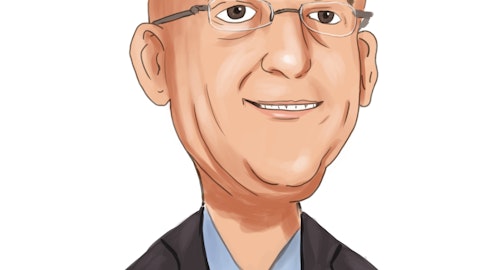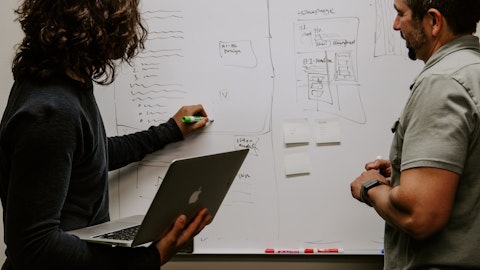Guess’, Inc. (NYSE:GES) Q4 2023 Earnings Call Transcript March 14, 2023
Operator: Good day, everyone, and welcome to the Guess’ Fourth Quarter Fiscal 2023 Earnings Conference Call. I would like to turn the call Fabrice Benarouche, Vice President of Finance and Investor Relations.
Fabrice Benarouche: Thank you, operator. Good afternoon, everyone, and thank you for joining us today. On the call today with me are Carlos Alberini, Chief Executive Officer; and Dennis Secor, Interim Chief Financial Officer. During today’s call, the company will be making forward-looking statements including comments regarding future plans, strategic initiatives, capital allocation and short and long-term outlook. The company’s actual results may differ materially from current expectations based on risk factors included in today’s press release and the company’s quarterly and annual reports filed with the SEC. Comments will also reference certain non-GAAP or adjusted measures. GAAP reconciliations and descriptions of these measures can be found in today’s earnings release. Now, I will turn it over to Carlos.
Carlos Alberini: Thank you, Fabrice. Good afternoon, everyone, and thank you for joining us today. I am very pleased to report our fourth quarter results, which exceeded our expectations for revenues, operating profit and earnings per share. This results cut a strong year for Guess, where we grew revenues by 4% in U.S. dollars and 12% in constant currency and delivered almost 10% in adjusted operating margin and $2.74 in adjusted earnings per share. We are very proud of our performance this year. And Paul and I want to thank our teams around the world for their commitment and strong execution. During the fourth quarter, our revenues increased by 2% in US dollars and 8% in constant currency, well ahead of our expectations. The revenue increase was driven primarily by our business in Europe which delivered strong top line growth and solid profit performance in spite of currency headwinds.
Our Europe results were driven by better than expected performance in our retail stores, including new stores, and solid results in our wholesale business due to increased shipments during the quarter. Our brand continues to enjoy strong momentum and our wholesale customers chose to take early deliveries when the product was available. Our Americas retail business posted a marginal decrease in revenues and a more significant reduction in operating earnings. This decrease was attributed to lower gross margins as a result of increased markdowns, partially offset by a higher initial markup. Our Americas wholesale segment revenues decreased meaningfully in the quarter as we experienced lower orders and cancellations from our customers as they tightly managed their overall inventory levels.
Despite achieving a higher gross margin in this business, operating earnings decreased due to higher expenses and deleveraging. Our Asia business recorded a reduction in both revenues and operating profit during the period, and this was primarily due to timing and revenue mix compared to the prior year. Although our Asia business is relatively small, we remain committed to its growth and continued success. Additionally, our licensing business also recorded a mild decrease in both revenues and operating earnings. However, the underlying sales for this business continued to be strong and delivered stellar performance for the entire year. Our strongest product categories in the fourth quarter were accessories led by handbags, small leather goods, travel products, fragrances, jewelry and eyewear.
We also saw strong results in our Marciano brands, activewear, dresses and our kids business. While sales of apparel for both men’s and women’s had similar performances, the more dressy products outperformed due to customers dressing up for holiday events. Conversely, the more casual part of the assortments experienced a deceleration in line with our third quarter trends. As we reflect on the full year, we are very pleased with our performance and the quality of our earnings. Although the pandemic became less of an issue for our business this year, there were significant changes in the environment and challenges that impacted our results which were beyond our control. Severe supply chain disruptions created product shortages and skyrocketing costs further aggravated the situation.
Additionally, the ongoing war in Ukraine disrupted energy flows, resulting in a significant increase in costs. These and other factors contributed to global inflation which undermine consumer confidence and put pressure on all aspects of our cost structure, including labor costs and rent. Our team did what we do best by focusing on the fundamentals and controlling the things that are within our control. We proactively tackled the supply chain issues by moving up deliveries, which help to protect product flows to our stores and deliveries to our wholesale partners. We managed inventories carefully and avoided creating excessive amounts of unsold stock. We used our capital wisely and prudently and we controlled our costs very effectively. And we stayed the course set by our brand elevations strategy and minimized promotional activities.
With our steady and disciplined approach, we captured growth opportunities and gained market share throughout the year, delivering growth in each one of our operating segments. However, we faced a frustrating challenge as a large portion of this growth was overshadowed by the most significant factor outside our control, currency fluctuations. Despite this challenge, we remain highly committed to delivering value to our stakeholders and will continue to do so in the future. For the year, in constant currencies, impressively, we grew our business by 12% to $2.9 billion, but currency headwinds consumed $217 million of that growth, resulting in the 4% U.S. dollar increase and $2.7 billion of revenues that we are reporting today. Beyond that, currencies consumed $62 million of operating profit and 140 basis points of operating margin.
When combined with mark to market changes, which we booked below the operating line, this factors represented $1.20 reduction to the $2.74 adjusted earnings per share for the year. If we similarly neutralized last year for currencies, our adjusted earnings per share this year would have grown roughly 20% compared to last year. And last year was exceptionally profitable due to the abnormally high margins that we achieved as a result of inventory shortages and reduced promotions in the market. We consider this a significant accomplishment and are immensely proud of our teams managing the business well, controlling what we could control. As we developed our strategic plan in 2019 pre-COVID, we identified several valuable opportunities for margin expansion.
We adopted a strategic approach with a focus on purchasing inventory based on anticipated demand, maximizing full price selling and reducing promotional activity. We identified opportunities to enhance productivity across functions, optimize our store portfolio, consolidate multiple functions manage capital effectively and expand our digital business with a new upgraded infrastructure. We built greater agility into our supply chains through the development of one global line. We remain steadfast in our commitment to further improving our operations and driving sustainable growth in the future. As we take a step back to evaluate where our business stands today and identify value creation opportunities for the future, we have significantly transformed the company and are moving forward from a position of strength.
Unequivocally, Paul led the way in our transformation that touched every aspect of our business. Paul’s vision to elevate our brand and his leadership and drive to inspire our teams resulted in amazing execution. Today, our brand innovation is visible in every aspect of our business. You can see it in the quality of our products, in the styling, in the consistency of our assortments and our commitment to sustainability. Today, we are proud to offer a global line of products for each of the 25 categories that we serve and every product is priced based on its customers perceived value for the market it is being offered. We have a product assortment that caters to the needs of our customers from casual to dressy occasions and the power and versatility of our brands appeals to a broad range of customer segments from Gen Z to millennials to heritage.
And in marketing, where we have never stopped investing our efforts have synchronized with the appropriate product deliveries for our omnichannel network. We have also elevated the customer experience, including new tools for our website and stores. Currently, we are developing a client selling app to personalize the in store experience and we are relying more in data analytics to optimize data collection, customer engagement, segmentation and personalization. Additionally, as part of our brand elevation initiative, we have invested in new stores, remodels, new imagery and enhanced visual presentations. As a result, 80% of the fleet today reflect a more elevated representation of our brand. Despite the significant progress that we have made in optimizing our business model, we remain vigilant in identifying further opportunities for margin expansion.
Our strategies include optimizing our assortments to improve sales productivity, enhancing inventory management to accelerate inventory turnover and increase margins and streamlining our supply chain to reduce costs an increase sourcing proximity for better market distribution. Looking forward, we are excited about the significant growth opportunities that lie ahead for our company, leveraging the robust capabilities that we have built during the 42 years that Guess has been in operation. We aim to achieve this growth gradually by prioritizing four key initiatives. Firstly, we will focus on increasing the sales productivity of our existing network, including our stores, websites, licensing and wholesale channels. Secondly, we will explore opportunities to grow organically in existing and new markets by expanding our store network and attracting new customers.
Thirdly, we will pursue further brand extensions and category expansions that leverage the strength of the Guess and Marciano brands. And finally, we will pursue strategic acquisitions of brands and businesses that leverage our global infrastructure and network of licensees and wholesale partners. We are confident that this growth strategy will result in tremendous value creation opportunities. And we are well positioned to support this initiative with our robust capital structure. Regarding our outlook for fiscal year 2024. We are taking a prudent approach based on our current business trends and the state of the consumer across markets. As Dennis will discuss in more detail shortly, we are planning the business with a low single digit revenue growth for the year.

Photo by Jake Pierrelee on Unsplash
We have actively sought opportunities for gross margin growth, primarily by reducing promotions and inbound freight costs. This efforts should result in strong profit performance as we anticipate delivering an operating margin between 8% and 9%. Before I hand over the call to Dennis, I would like to reflect on the past four years since my return to Guess and how the world has undergone significant changes in that time. I am proud of how our entire organization has embraced these changes and how we have adapted to a new era of shopping, working and living. Our customers have responded positively to our transformation. Thanks to those efforts and vision, our products have never been better. Our brands are thriving globally and we have a robust business model that is capable of delivering strong margins and high returns on invested capital.
Furthermore, we have numerous opportunities to expand and leverage our global platform. And above all, we have an exceptional team that is highly capable and committed to achieving our goals and delivering value to our shareholders. I’m excited about our future and eager to share with you what lies ahead. With that, I would now like to hand the call over to Dennis, who will provide a more in-depth review of our financial results and outlook. Dennis?
Dennis Secor: Thank you, Carlos, and good afternoon, everyone. So let me share the highlights of our regional performance for the quarter starting with Europe, where we posted a 20% constant currency revenue increase and a 10% increase in U.S. dollars. The revenue growth was mainly driven by positive store comps, higher wholesale shipments and net new stores. These were partially offset by the significant headwind from the strong U.S. dollar. Our stores in the region posted a 20% constant currency comp increase in the quarter, driven by continued strong store traffic and AUR growth given our price increases. Just as in the third quarter, Turkey’s hyperinflation had an outsized impact on the comps. Excluding Turkey, our European store constant currency comp increase would have been 15%.
European operating earnings decreased 5% and operating margin declined 260 basis points as the benefit of sales growth was more than offset by the negative impact of currencies and the prior year’s fourth quarter COVID subsidies, which did not repeat this year. In Americas retail, revenues decreased 1%, both in U.S. dollars and in constant currency. Comp store sales declined 1% in constant currency driven by lower conversion, partially offset by higher AUR and traffic. Somewhat offsetting this decline was growth from our e-com business as well as new stores. Again this quarter, our tourist locations outperformed the rest of our store fleet though that differential is narrowing as we are anniversarying a more normalized level of travel in the U.S. Americas retail operating profit declined 12% and operating margin declined 180 basis points, driven by a lower mix of full price selling and higher occupancy costs, partially offset by an IMU improvement.
In Americas wholesale, revenues declined by 27%, both in U.S. dollars in constant currency. Our U.S. wholesale partners continue to tightly manage their own inventory levels and limit their receipts. Operating profit declined 40% and operating margin declined 450 basis points as deleverage and expense increases offset an expansion of gross margin. In Asia, revenue declined 8% in US dollars and grew 1% in constant currency. The modest growth was driven by the impact of the direct operation of some of our stores in Korea and positive constant currency comp store sales of 4%. Offsetting those increases was the impact at the deliveries to those acquired stores. Last year, our Q4 deliveries of product to those then partner owned stores was recognized as Q4 wholesale revenues.
Now that we own those stores, we don’t record revenue until the sale is made to the consumer. Permanent store closures in China and Japan also represented a sales headwind in the quarter. Operating profit declined 60% and the operating margin declined 370 basis points, largely due to the mix shift between wholesale and retail. And finally, in our Licensing segment, royalty revenues declined 8%, segment operating profit was $22 million, a $2 million decline from last year’s Q4. In the quarter, total company gross margin contracted 210 basis points to 44.2% more than two-thirds of which was driven by currency headwinds. Also affecting gross margin was a higher mix of markdowns given last year’s inventory scarcity in our own inventories, as well as this year’s higher competitor inventory levels and the resulting promotional environment.
Adjusted SG&A for the fourth quarter increased 4% to $254 million. The primary drivers of our expense increase were higher store selling expenses, including the impact of labor inflation as well as higher selling costs to support our wholesale growth. In Q4 last year, we also received government subsidies, which did not repeat this year, partially offsetting those factors were a $13 million favorable currency impact and lower performance based compensation charges, given last year’s exceptionally strong performance relative to operating goals. For the quarter, our adjusted SG&A rate increased 50 basis points to 31.1%. Our fourth quarter adjusted operating profit was $108 million, 14% lower than last year and our adjusted operating margin was 13.1%, 260 basis points lower than last year’s Q4.
Currency had a negative $20 million impact on adjusted operating profit and represented a 160 basis point headwind to the adjusted operating margin. In the quarter, we recorded non-operating net income of $1 million. This includes charges on the revaluation of certain of our foreign subsidiaries net assets and liabilities into U.S. dollars and net gains to mark our deferred comp plan and SERP plan assets to market. Our fourth quarter adjusted tax rate was 5% compared to a rate of 25% in last year’s fourth quarter. In the quarter, we recorded a discrete tax benefits related to one of our international subsidiaries, which accounts for most of the year-over-year rate change. Adjusted diluted EPS in the quarter was $1.74 versus $1.14 in the fourth quarter of fiscal 2022.
We are very pleased with these results. Moving to the balance sheet. We ended the year with $276 million in cash compared to $416 million a year ago. Our $140 million year-over-year cash consumption was driven primarily by the $187 million of share repurchases executed in the last 12 months. We ended the year with a total of $353 million of borrowing availability on our various global facilities. Inventories were $511 million, up 11% in U.S. dollars and 13% in constant currency versus last year. Our inventory growth primarily reflects this year’s strategy to order product earlier to mitigate supply chain constraints. We’re very pleased with our inventory composition and in our proactive management of inventory this year. As supply chains have been recovering, we have already reduced this growth rate over the past few quarters.
And as we return to a more traditional receipt cadence in fiscal 2024, our plan is to further reduce our inventory levels. Our receivables were $342 million, a 4% increase versus last year’s $329 million. On a constant currency basis, receivables increased about 7% as a result of the growth in our wholesale business in Europe. For the year, capital expenditures were $90 million, up from $64 million in the prior year, mainly driven by investments in the remodeled, new stores and technology. Free cash flow for the year totaled $72 million versus $61 million in the prior year with higher operating cash flow being partially offset by this year’s higher capital spending. Last year’s operating cash flow was impacted by the $108 million tax payment made associated with our IP transfer to Europe.
Today, we also announced that our Board approved our quarterly dividend of $0.225, which at recent stock prices represents an annual yield over 4%. So now let’s talk about our outlook for fiscal 2024 and the first quarter. Some of the dynamics that affected our business and the consumer last year have changed, while others persist. Supply chains have largely recovered, yielding more reliable deliveries and while not yet completely back to more normal levels, freight costs have improved significantly. On currencies, at least for now, the volatility has subsided. The U.S. dollar has weakened somewhat from its most recent highs. COVID restrictions have at least for the moment been lifted in China and throughout Asia allowing retailers to once again operate in a more normal way.
On the other hand, inflation remains high throughout the world and while there are signs of some easing, pressure from rising interest rates may take its place and weigh on consumer spending. Uncertainty about the implications of the Ukraine war remain and the U.S. debt ceiling and current instability in the banking system pose a significant risk to the global economy. Overall, we expect the consumer to remain prudent in their spending, wanting to shop, but continuing to be very focused on price. It also remains to be seen how the European consumer will behave now that they’re in their second year of more normalized post pandemic shopping. And we expect retailers will prioritize maintaining tighter inventories than last year. Cleaner inventories among retailers should tighten the competitive environment and help to lessen the use of markdowns especially in the U.S. But it will also have implications on the top line in our wholesale business as we consider those retailers who carry our products.
Based on these assumptions, for the full 2024 fiscal year, we are expecting total company revenue growth in the range of 1% to 3% with only a minimal impact of currencies on this range. This year will also include an extra week in the fourth quarter and we estimate that will represent roughly 1 point of sales growth. As we consider this year’s profitability, we anticipate both tailwinds and headwinds will affect our bottom line. Let me start with some tailwinds. With supply chains now largely recovered, we expect that improved shipping costs will represent a benefit to our IMU. With our assumption that competitors will manage their inventories with greater discipline, we would expect an improvement in the overall promotional environment allowing us to recover some of last year’s markdown rate.
We estimate the combined benefit from shipping costs and markdown improvements will be roughly one full point of margin. And the revenue growth, including the impact of the 53rd week should benefit our overall annual operating margin by about 1.5 points. There are also some headwinds as we go into fiscal 2024. The first is currencies. For the full year, at prevailing exchange rates, we expect that currencies will represent about a 70 basis point headwind. Like so many others, we are experiencing inflationary pressure on our expenses, including labor costs and store occupancy. While last year we received COVID related subsidies from several governments around the world, we are not planning for those offsets to expenses to repeat this year. And as we anticipated and said on the prior call, last year’s performance did not meet all of our performance based compensation targets.
Those targets are reset each year, so meeting those targets this year would result in a greater year-over-year expense. We estimate all these headwinds in total will negatively impact operating margin by roughly 2.5 points with about half the pressure coming from inflation. All those factors when taken together would represent roughly 1 point of net operating margin decline with that headwind increasing if we achieve the lower end of our revenue outlook. Therefore, based on those assumptions for the full year, we expect operating margin in the range between 8% and 9%. Below operating income, our currency assumptions would result in a small mark to market loss for the year compared with the substantial charges we recorded last year with this year’s loss being recorded in Q1.
We are also planning a lower average outstanding share count this year given the annualization impact from last year’s share repurchases. Those two factors would favorably affect EPS. Partially offsetting those, this past year we recorded a discrete income tax benefit and we are not planning for that to recur. Accordingly for the full year, we expect adjusted EPS between $2.45 and $2.80 per share. Turning to the first quarter, we expect to experience most of the same dynamics as the full year. However, the COVID related subsidies disproportionately benefited last year’s first quarter. In our Americas wholesale business, the timing of shipments last year was heavily weighted to Q1. And in Europe, the shipping calendar for the spring summer collection which shifts during the fourth and first quarters has been shifting forward.
That benefited revenues in the quarter we just closed by roughly $25 million, about half of which we had anticipated. That $25 million calendar shift will now negatively affect Q1 of the current year. Therefore for the first quarter, we expect U.S. dollar revenues to decline between 6% and 7%, which includes roughly a 3 point currency headwind. We expect an adjusted operating loss margin between 0.5% and 1.2% and adjusted loss per share between $0.25 and $0.31. As we look beyond the first quarter, we expect the middle quarters will experience modest operating profit pressure given the dynamics of more prudent top line assumptions, coupled with the cost headwinds we described. The fourth quarter should represent our most significant opportunity for operating margin expansion.
In addition to the extra week in Q4, we’d expect that by the fourth quarter we will have already absorbed significant inflationary cost pressures. Last, on capital allocation, we are planning for our inventory levels to normalize and inventory turns to improve as supply chain disruptions have mostly subsided. In line with our brand elevation strategy, we have invested in remodeling many stores and opening new locations in the last couple of years and now have updated significant portion of our fleet. As a result, we are planning for lower levels of CapEx investments in fiscal 2024 versus 2023. This year, we also expect to complete the previously announced acquisition of the remaining 30% interest in our Russia business, which is currently pending Russian government approvals.
All told, when you consider our offer profit and tight capital management this year, these should help generate free cash flow of roughly $150 million for the full year. In closing, we are proud of our results and our teams work and excited for our company’s future. With that, I will conclude the company’s remarks and let’s open up the call for your questions.
See also 14 Best Falling Stocks To Buy Now and 12 Best US Chemical Stocks To Buy Now.
Q&A Session
Follow Guess Inc (NYSE:GES)
Follow Guess Inc (NYSE:GES)
Operator: Thank you. One moment for our first question. And it comes from the line of Corey Tarlowe with Jefferies. Please proceed.
Corey Tarlowe: Hi. Good afternoon and thanks for taking my question. So Carlos. As you reflected on your four year journey so far with Guess, it’s clear that your focus has really been about elevating the Guess brand and representation of that brand and innovating around product and marketing to continue to drive sales and margins. So could you maybe talk a little bit about what you’re really excited about as you think about what initiatives you have planned for the next 12 months to continue upon that strategy that you highlighted earlier?
Carlos Alberini: Yes. Thank you for the question, Corey. Well, I have been here now for four years, back here for four years. And at the beginning, when I joined the first thing that we did with the team was to really develop a strategic plan. We looked at the opportunities that we thought will create the biggest value and we identified multiple opportunities to expand margins. And I think that that was the right thing to do at the time. That year, I think, the company close with an operating margin of 5.3% and we saw that there was a lot there to be able to reverse that and expand the margins to double digit standard. And then COVID hit. And with COVID, we not only continue to execute secured on that plan, but we accelerated many of the initiatives that we had set out to do.
One of them was the expansion of our digital business and investment to upgrade the infrastructure that we had. There were several things about operations, distribution network in Europe that was not working very well and so forth. But we identified a big opportunity to elevate the brands and really here is where Paul really took the charge and led the teams and the product teams to really go after this elevation of the brand. And I think it was an incredible strategy. It’s working very well for us. And we were able to really transform the company, because this initiative touched every single point in the business at a global level. So probably one of the biggest initiatives within that one was to develop and launch a global line of product for every market.
This is working very well as you can see the consistency of the presentations across markets, but also seeing that the best sellers are best sellers in every market. Which I think confirms our initial idea that this is a brand that should be represented with a global line of product across every territory and every point of distribution. And I think that now as we look back, I think we did a very good job, the teams really excelled at operating this business and executing on that plan. But what we see now is that, we have great margin business, highly diversified and now we can look at growth opportunities. And that’s why we are talking about this four big pillars that we have identified. The first one is about just what we do internally opportunity to improve sales productivity.
We see a lot of factors here that could be improved with positive comp sales, even in our wholesale distribution, our digital business can continue to expand. And we see that with the investments that we have made both in digital but also in our stores, we are poised for that growth and that opportunity in self-productivity improvement. The second big pillar is about expanding in the market, whether we are in there or we are not. And we see that we do very well with our omnichannel approach when we approach any market. And we think that there is an opportunity for a store network expansion also in digital and also acquiring news new customers in those markets. So that’s the second pillar. The third pillar is about brand extensions. We think that our brands are strong and they have a lot of momentum.





